Wildfires During Early Summer in Greece (2024): Burn Severity and Land Use Dynamics Through Sentinel-2 Data
Abstract
:1. Introduction
2. Materials and Methods
2.1. Study Area
2.2. Weather Conditions
2.3. Data Used
2.4. Methodology
3. Results
3.1. Burned Areas and Burn Severity
3.2. Land Cover of the Burned Area
3.3. Tree Cover Density of the Burned Area
3.4. Validation of the Burned Area
4. Discussion
4.1. Implications for Fire Management and Land Use Planning
4.2. Methodological Considerations and Future Research
4.3. Policy and Conservation Implications
5. Conclusions
Author Contributions
Funding
Data Availability Statement
Acknowledgments
Conflicts of Interest
References
- Lizundia-Loiola, J.; Otón, G.; Ramo, R.; Chuvieco, E. A Spatio-Temporal Active-Fire Clustering Approach for Global Burned Area Mapping at 250 m from MODIS Data. Remote Sens. Environ. 2020, 36, 111493. [Google Scholar] [CrossRef]
- San-Miguel-Ayanz, J.; Durrant, T.; Boca, R.; Maianti, P.; Libertà, G.; Jacome Felix Oom, D.; Branco, A.; De Rigo, D.; Suarez-Moreno, M.; Ferrari, D.; et al. Forest Fires in Europe, Middle East and North Africa 2023; Publications Office of the European Union: Luxembourg, 2023; JRC139704. [Google Scholar] [CrossRef]
- Silvestro, R.; Saulino, L.; Cavallo, C.; Allevato, E.; Pindozzi, S.; Cervelli, E.; Conti, P.; Mazzoleni, S.; Saracino, A. The Footprint of Wildfires on Mediterranean Forest Ecosystem Services in Vesuvius National Park. Fire 2021, 4, 95. [Google Scholar] [CrossRef]
- Our World in Data. Available online: https://ourworldindata.org/grapher/annual-carbon-dioxide-emissions?tab=table (accessed on 19 January 2025).
- Wilgus, M.-L.; Merchant, M. Clearing the Air: Understanding the Impact of Wildfire Smoke on Asthma and COPD. Healthcare 2024, 12, 307. [Google Scholar] [CrossRef]
- Matzarakis, A.; Nastos, P. Greece 2023: Crazy Summer or New Normal—Lessons Not Learned. Atmosphere 2024, 15, 1241. [Google Scholar] [CrossRef]
- Wasserman, T.N.; Mueller, S.E. Climate influences on future fire severity: A synthesis of climate-fire interactions and impacts on fire regimes, high-severity fire, and forests in the western United States. Fire Ecol. 2023, 19, 43. [Google Scholar] [CrossRef]
- Parente, J.; Tonini, M.; Stamou, Z.; Koutsias, N.; Pereira, M. Quantitative Assessment of the Relationship between Land Use/Land Cover Changes and Wildfires in Southern Europe. Fire 2023, 6, 198. [Google Scholar] [CrossRef]
- Williams, A.P.; Abatzoglou, J.T. Recent Advances and Remaining Uncertainties in Resolving Past and Future Climate Effects on Global Fire Activity. Curr. Clim. Change Rep. 2016, 2, 1–14. [Google Scholar] [CrossRef]
- Intergovernmental Panel on Climate Change (IPCC). Climate Change 2021—The Physical; Cambridge University Press: Cambridge, UK, 2023; pp. 46–51. [Google Scholar] [CrossRef]
- Nwayor, I.-J.; Robeson, S.-M.; Ficklin, D.; Maxwell, J.-T. A Multiscalar Standardized Vapor Pressure Deficit Index for Drought Monitoring and Impacts. Int. J. Climatol. 2024, 44, 5825–5838. [Google Scholar] [CrossRef]
- Dosiou, A.; Athinelis, I.; Katris, E.; Vassalou, M.; Kyrkos, A.; Krassakis, P.; Parcharidis, I. Employing Copernicus Land Service and Sentinel-2 Satellite Mission Data to Assess the Spatial Dynamics and Distribution of the Extreme Forest Fires of 2023 in Greece. Fire 2024, 7, 20. [Google Scholar] [CrossRef]
- Koukouli, M.-E.; Pseftogkas, A.; Karagkiozidis, D.; Mermigkas, M.; Panou, T.; Bais, A. Extreme Wildfires Over Northern Greece During Summer 2023—Part B. Adverse Effects on Regional Air Quality. SSRN, 2024; preprint. [Google Scholar] [CrossRef]
- Williams, A.P.; Allen, C.D.; Millar, C.I.; Swetnam, T.W.; Michaelsen, J.; Still, C.J.; Leavitt, S.W. Forest responses to increasing aridity and warmth in the southwestern United States. Proc. Natl. Acad. Sci. USA 2010, 107, 21289–21294. [Google Scholar] [CrossRef] [PubMed]
- Williams, A.P.; Allen, D.A.; Macalady, A.K.; Griffin, D.; Woodhouse, C.A.; Meko, D.M.; Swetnam, T.W.; Rauscher, S.A.; Seager, R.; Grissino-Mayer, H.D.; et al. Temperature as a Potent Driver of Regional Forest Drought Stress and Tree Mortality. Nat. Clim. Change 2012, 3, 292–297. [Google Scholar] [CrossRef]
- Politi, N.; Vlachogiannis, D.; Sfetsos, A. A Statistical Analysis of Drought and Fire Weather Indicators in the Context of Climate Change: The Case of the Attica Region, Greece. Climate 2024, 12, 135. [Google Scholar] [CrossRef]
- Pülzl, H.; Hogl, K. Forest governance in Europe. In European Forest Governance: Issues at Stake and the Way Forward, What Science Can Tell Us; Pülzl, H., Hogl, K., Kleinschmit, D., Wydra, D., Arts, B., Mayer, P., Palahi, M., Winkel, G., Wolfslehner, B., Eds.; European Forest Institute: Joensuu, Finland, 2013. [Google Scholar]
- Costafreda-Aumedes, S.; Vega-Garcia, C.; Comas, C. Improving fire season definition by optimized temporal modelling of daily human-caused ignitions. J. Environ. Manag. 2018, 217, 90–99. [Google Scholar] [CrossRef] [PubMed]
- Xanthopoulos, G. Who Should Be Responsible for Forest Fires? Lessons From the Greek Experience. In Proceedings of the Second International Symposium on Fire Economics, Planning, and Policy: A Global View, Albany, CA, USA, 23–27 June 2008; Pacific Southwest Research Station, Forest Service, US Department of Agriculture: Albany, CA, USA, 2008. [Google Scholar]
- Civil Protection Department. Available online: https://rischi.protezionecivile.gov.it/en/fire/activities/ (accessed on 6 December 2024).
- Arianoutsou, M.; Zerefos, C.; Kalabokidis, K.; Poupkou, A.; Aravanopoulos, F. Climate change and resilience of forest ecosystems. In Resilience of Forest Ecosystems of Greece to Climate Change; Committee for the Resilience of the Greek Forest Ecosystems to Climate Change (EADO), Arianoutsou, M., Zerefos, C., Kalabokidis, K., Poupkou, A., Aravanopoulos, F., Eds.; Academy of Athens: Athens, Greece, 2023. [Google Scholar]
- Bolaño-Díaz, S.; Camargo-Caicedo, Y.; Soro, T.D.; N’Dri, A.B.; Bolaño-Ortiz, T.R. Spatio-Temporal Characterization of Fire Using MODIS Data (2000–2020) in Colombia. Fire 2022, 5, 134. [Google Scholar] [CrossRef]
- Basiou, E.; Castro-Melgar, I.; Kranis, H.; Karavias, A.; Lekkas, E.; Parcharidis, I. Assessment of the Ground Vulnerability in the Preveza Region (Greece) Using the European Ground Motion Service and Geospatial Data Concerning Critical Infrastructures. Remote Sens. 2025, 17, 327. [Google Scholar] [CrossRef]
- Kalavrezou, I.E.; Castro-Melgar, I.; Nika, D.; Gatsios, T.; Lalechos, S.; Parcharidis, I. Application of Time Series INSAR (SBAS) Method Using Sentinel-1 for Monitoring Ground Deformation of the Aegina Island (Western Edge of Hellenic Volcanic Arc). Land 2024, 13, 485. [Google Scholar] [CrossRef]
- Lam, C.N.; Niculescu, S.; Bengoufa, S. Monitoring and mapping floods and floodable areas in the Mekong Delta (Vietnam) using time-series sentinel-1 images, convolutional neural Network, multi-layer perceptron, and random forest. Remote Sens. 2023, 15, 2001. [Google Scholar] [CrossRef]
- Lekkas, E.; Meletlidis, S.; Kyriakopoulos, K.; Manousaki, M.; Mavroulis, S.; Kostaki, E.; Michailidis, A.; Gogou, M.; Mavrouli, M.; Castro-Melgar, I.; et al. The 2021 Cumbre Vieja volcano eruption in La Palma (Canary Islands). Newsl. Environ. Disaster Cris. Manag. Strateg. 2021, 26, 167. [Google Scholar] [CrossRef]
- Gibson, L.; Engelbrecht, J.; Rush, D. Detecting historic informal settlement fires with sentinel 1 and 2 satellite data-Two case studies in Cape Town. Fire Saf. J. 2019, 108, 102828. [Google Scholar] [CrossRef]
- Roy, D.P.; Huang, H.; Boschetti, L.; Giglio, L.; Yan, L.; Zhang, H.H.; Li, Z. Landsat-8 and Sentinel-2 burned area mapping—A combined sensor multi-temporal change detection approach. Remote Sens. Environ. 2019, 231, 111254. [Google Scholar] [CrossRef]
- Chuvieco, E.; Mouillot, F.; Van der Werf, G.R.; San Miguel, J.; Tanase, M.; Koutsias, N.; García, M.; Yebra, M.; Padilla, M.; Gitas, I.; et al. Historical Background and Current Developments for Mapping Burned Area from Satellite Earth Observation. Remote Sens. Environ. 2019, 225, 45–64. [Google Scholar] [CrossRef]
- Barboza, E.; Turpo, E.Y.; Tariq, A.; Salas López, R.; Pizarro, S.; Zabaleta-Santisteban, J.A.; Medina-Medina, A.J.; Tuesta-Trauco, K.M.; Oliva-Cruz, M.; Vásquez, H.V. Spatial Distribution of Burned Areas from 1986 to 2023 Using Cloud Computing: A Case Study in Amazonas (Peru). Fire 2024, 7, 413. [Google Scholar] [CrossRef]
- Gibson, R.; Danaher, T.; Hehir, W.; Collins, L. A Remote Sensing Approach to Mapping Fire Severity in South-Eastern Australia Using Sentinel-2 and Random Forest. Remote Sens. Environ. 2020, 240, 111702. [Google Scholar] [CrossRef]
- Zennir, R.; Khallef, B. Forest fire area detection using Sentinel-2 data: Case of the Beni Salah national forest—Algeria. J. For. Sci. 2023, 69, 33–40. [Google Scholar] [CrossRef]
- A European Forest Fire Information System (EFFIS). Available online: https://forest-fire.emergency.copernicus.eu/apps/effis.statistics/estimates/GRC (accessed on 3 November 2024).
- Μεγάλη Φωτιά στη Βάρης—Κορωπίου: Ζημιές σε Σπίτια και Επιχειρήσεις, Έκλεισαν Δρόμοι—Εκκένωση σε Λαμπρικά—Κίτσι. The TOC. 2024. Available online: https://www.thetoc.gr/koinwnia/article/megali-fotia-sti-baris---koropiou-kaigontai-spitia-ekleise-i-exodos-tis-attikis-odou---ekkenosi-se-lamprika-kai-kitsi/ (accessed on 4 November 2024).
- Time and Date. Available online: https://www.timeanddate.com/weather/@257605/historic?month=6&year=2024 (accessed on 5 November 2024).
- Copernicus Emergency Management Service (CMS). EMSR730: Copernicus Emergency Mapping Service Rapid Mapping Activation. Copernicus EMS. 2024. Available online: https://rapidmapping.emergency.copernicus.eu/EMSR730 (accessed on 5 November 2024).
- Time and Date. Available online: https://www.timeanddate.com/weather/@9036675/climate (accessed on 5 November 2024).
- Time and Date. Available online: https://www.timeanddate.com/weather/@257605/climate (accessed on 5 November 2024).
- Time and Date. Available online: https://www.timeanddate.com/weather/@11026795/climate (accessed on 26 November 2024).
- Time and Date. Available online: https://www.timeanddate.com/weather/@253302/climate (accessed on 26 November 2024).
- Dataspace Copernicus EU. Available online: https://dataspace.copernicus.eu/ (accessed on 31 October 2024).
- European Space Agency; European Commission. Sentinel-2 User Handbook; European Space Agency: Paris, France, 2015. [Google Scholar]
- Corine Land Cover (CLC 2018). Copernicus Land Monitoring Service. Available online: https://land.copernicus.eu/en/products/corine-land-cover/clc2018 (accessed on 31 October 2024).
- Tree Cover Density 2018 (TCD). Copernicus Land Monitoring Service. Available online: https://land.copernicus.eu/en/products/high-resolution-layer-tree-cover-density/tree-cover-density-2018 (accessed on 31 October 2024).
- Copernicus Land Monitoring Service; European Environment Agency. Copernicus Land Monitoring Service—High Resolution Land Cover Characteristics—Tree-Cover/Forest and Change 2015–2018; User Manual; European Environment Agency: Copenhagen, Denmark, 2018. [Google Scholar]
- Copernicus Land Monitoring Service; European Environment Agency. Tree Cover Density 2018 (Raster 10 m), Europe, 3-Yearly, Sep. 2020; European Environment Agency: Copenhagen, Denmark, 2020. [Google Scholar]
- Falaras, T.; Tselka, I.; Papadopoulos, I.; Nikolidaki, M.; Karavias, A.; Bafi, D.; Petani, A.; Krassakis, P.; Parcharidis, I. Operational Mapping and Post-Disaster Hazard Assessment by the Development of a Multiparametric Web App Using Geospatial Technologies and Data: Attica Region 2021 Wildfires (Greece). Appl. Sci. 2022, 12, 7256. [Google Scholar] [CrossRef]
- Alcaras, E.; Costantino, D.; Guastaferro, F.; Parente, C.; Pepe, M. Normalized Burn Ratio Plus (NBR+): A New Index for Sen-tinel-2 Imagery. Remote Sens. 2022, 14, 1727. [Google Scholar] [CrossRef]
- European Space Agency. SNAP Tool. Earth Observation Portal. Available online: https://earth.esa.int/eogateway/tools/snap (accessed on 17 January 2025).
- Esri. ArcGIS Desktop: Overview. Available online: https://www.esri.com/en-us/arcgis/products/arcgis-desktop/overview (accessed on 17 January 2025).
- Normalized Burn Ratio (Nbr)|Un-Spider Knowledge Portal. Available online: https://un-spider.org/advisory-support/recommended-practices/recommended-practice-burn-severity/in-detail/normalized-burn-ratio (accessed on 30 October 2024).
- Heidari, F.B.; Arfania, R. Wildfire Susceptibility Mapping using NBR Index and Frequency Ratio Model. Geoconservation Res. 2022, 5, 240–260. [Google Scholar] [CrossRef]
- Key, C.; Benson, N. The Normalized Burned Ratio, a Landsat TM Radiometric Index of Burn Severity Incorporating Multi-Temporal Differencing; Geological Surney: Reston, VA, USA, 1999. [Google Scholar]
- Kovács, K.D. Evaluation of Burned Areas with Sentinel-2 Using SNAP: The Case of Kineta and Mati, Greece, July 2018. Geogr. Tech. 2019, 14, 20–38. [Google Scholar] [CrossRef]
- McFeeters, S.K. The use of the Normalized Difference Water Index (NDWI) in the delineation of open water features. Int. J. Remote Sens. 1996, 17, 1425–1432. [Google Scholar] [CrossRef]
- Parks, S.A.; Dillon, G.K.; Miller, C. A new metric for quantifying burn severity: The relativized burn ratio. Remote Sens. 2014, 6, 1827–1844. [Google Scholar] [CrossRef]
- Arisanty, D.; Ramadhan, M.F.; Angriani, P.; Muhaimin, M.; Saputra, A.N.; Hastuti, K.P.; Rodadi, D. Utilizing Sentinel-2 Data for Mapping Burned Area in Banjarbaru Wetlands, South Kalimantan Province. Int. J. For. Res. 2022, 2022, 7936392. [Google Scholar] [CrossRef]
- Roy, D.P.; Boschetti, L.; Trigg, S.N. Remote sensing of fire severity: Assessing the performance of the normalized burn ratio. IEEE Geosci. Remote Sens. Lett. 2006, 3, 112–116. [Google Scholar] [CrossRef]
- Key, C.H.; Benson, N.C. Landscape Assessment (LA). FIREMON: Fire Effects Monitoring and Inventory System; General Technical Report RMRS-GTR-164-CD; U.S. Department of Agriculture Forest Service: Washington, DC, USA, 2006; pp. LA-1–LA-51. [Google Scholar]
- Miller, J.D.; Thode, A.E. Quantifying burn severity in a heterogeneous landscape with a relative version of the delta Normalized Burn Ratio (dNBR). Remote Sens. Environ. 2007, 109, 66–80. [Google Scholar] [CrossRef]
- Cocke, A.E.; Fulé, P.Z.; Crouse, J.E. Comparison of Burn Severity Assessments Using Differenced Normalized Burn Ratio and Ground Data. Int. J. Wildland Fire 2005, 14, 189–198. [Google Scholar] [CrossRef]
- Franco, M.G.; Mundo, I.A.; Veblen, T.T. Field-Validated Burn-Severity Mapping in North Patagonian Forests. Remote Sens. 2020, 12, 214. [Google Scholar] [CrossRef]
- Rozario, P.F.; Madurapperuma, B.D.; Wang, Y. Remote Sensing Approach to Detect Burn Severity Risk Zones in Palo Verde National Park, Costa Rica. Remote Sens. 2018, 10, 1427. [Google Scholar] [CrossRef]
- Sismanis, M.; Chadoulis, R.-T.; Manakos, I.; Drosou, A. An Unsupervised Burned Area Mapping Approach Using Sentinel-2 Images. Land 2023, 12, 379. [Google Scholar] [CrossRef]
- Lee, K.; Kim, B.; Park, S. Evaluating the Potential of Burn Severity Mapping and Transferability of Copernicus EMS Data Using Sentinel-2 Imagery and Machine Learning Approaches. GISci. Remote Sens. 2023, 60, 2192157. [Google Scholar] [CrossRef]
- Pinto, M.M.; Trigo, R.M.; Trigo, I.F.; DaCamara, C.C. A Practical Method for High-Resolution Burned Area Monitoring Using Sentinel-2 and VIIRS. Remote Sens. 2021, 13, 1608. [Google Scholar] [CrossRef]
- XXI The Emergency Management Service—Mapping. Copernicus EMS—Mapping. Available online: http://emergency.copernicus.eu/mapping/ems/emergency-management-service-mapping (accessed on 11 November 2024).
- Howe, A.A.; Parks, S.A.; Harvey, B.J.; Saberi, S.J.; Lutz, J.A.; Yocom, L.Y. Comparing Sentinel-2 and Landsat 8 for Burn Severity Mapping in Western North America. Remote Sens. 2022, 14, 5249. [Google Scholar] [CrossRef]
- Konkathi, P.; Shetty, A. Inter comparison of post-fire burn severity indices of Landsat-8 and Sentinel-2 imagery using Google Earth Engine. Earth. Sci. Inform. 2021, 14, 645–653. [Google Scholar] [CrossRef]
- Donezar-Hoyos, U.; Albizua-Huarte, L.; Amezketa-Lizarraga, E.; Barinagarrementeria-Arrese, I.; Ciriza, R.; de Blas-Corral, T.; Larrañaga-Urien, A.; Ros-Elso, F.; Tamés-Noriega, A.; Viñuales-Lasheras, M.; et al. The Copernicus EMS Validation Service as a vector for improving the emergency mapping based on Sentinel data. Rev. Teledetec. 2020, 56. [Google Scholar] [CrossRef]
- Franquesa, M.; Rodriguez-Montellano, A.M.; Chuvieco, E.; Aguado, I. Reference Data Accuracy Impacts Burned Area Product Validation: The Role of the Expert Analyst. Remote Sens. 2022, 14, 4354. [Google Scholar] [CrossRef]
- Saulino, L.; Rita, A.; Migliozzi, A.; Maffei, C.; Allevato, E.; Garonna, A.P.; Saracino, A. Detecting Burn Severity across Mediterranean Forest Types by Coupling Medium-Spatial Resolution Satellite Imagery and Field Data. Remote Sens. 2020, 12, 741. [Google Scholar] [CrossRef]
- Fernández-García, V.; Quintano, C.; Taboada, A.; Marcos, E.; Calvo, L.; Fernández-Manso, A. Remote Sensing Applied to the Study of Fire Regime Attributes and Their Influence on Post-Fire Greenness Recovery in Pine Ecosystems. Remote Sens. 2018, 10, 733. [Google Scholar] [CrossRef]

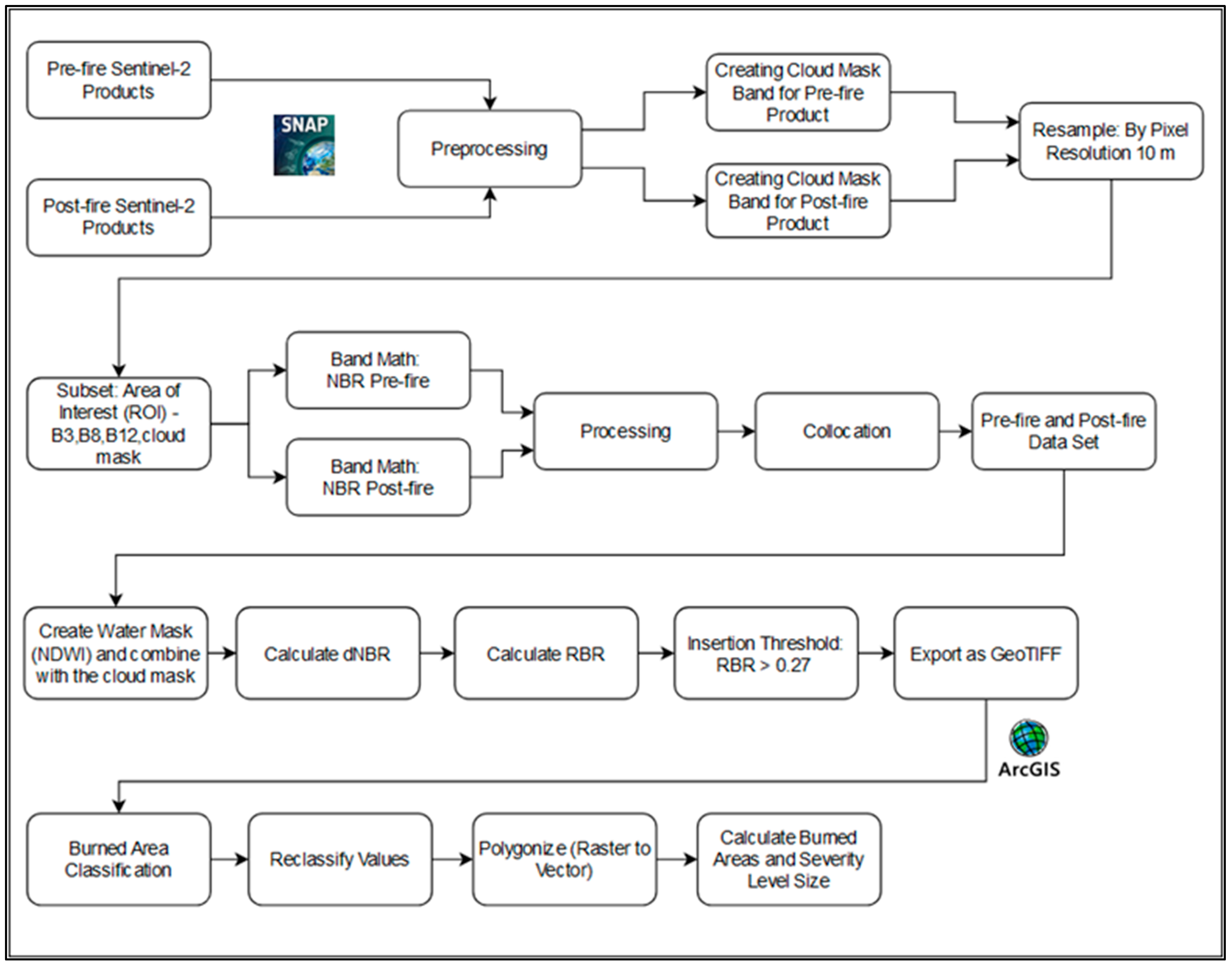

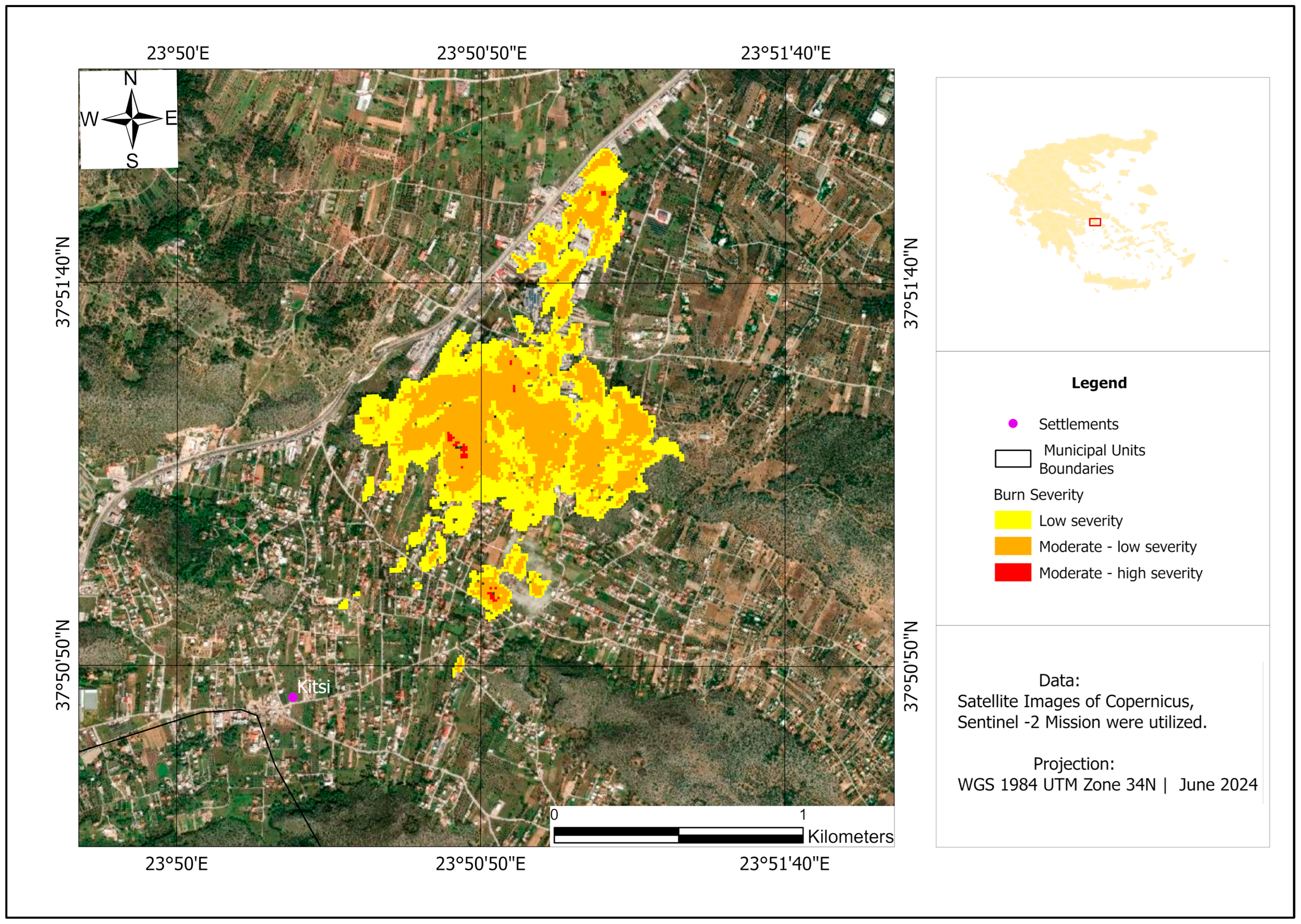
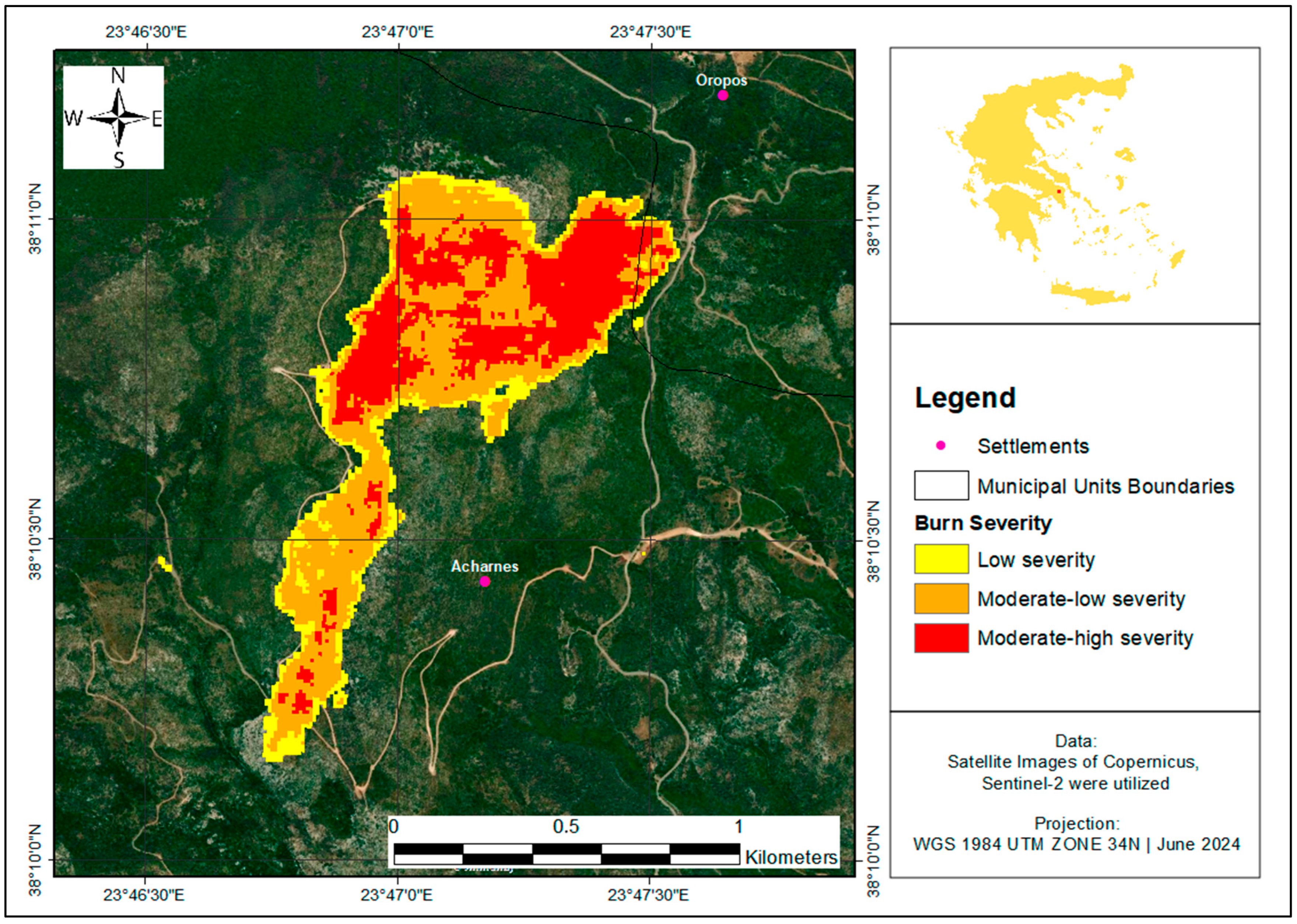

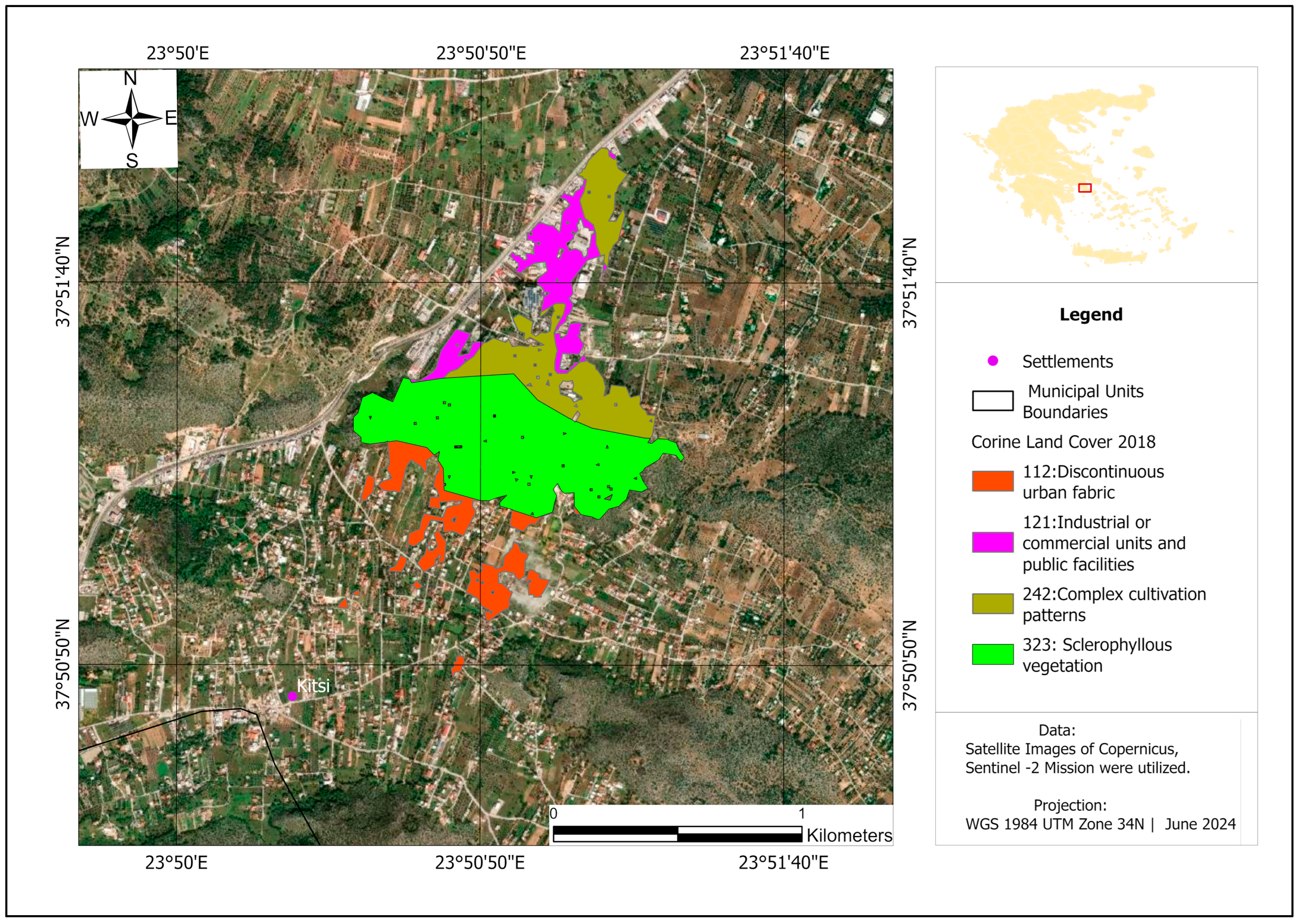


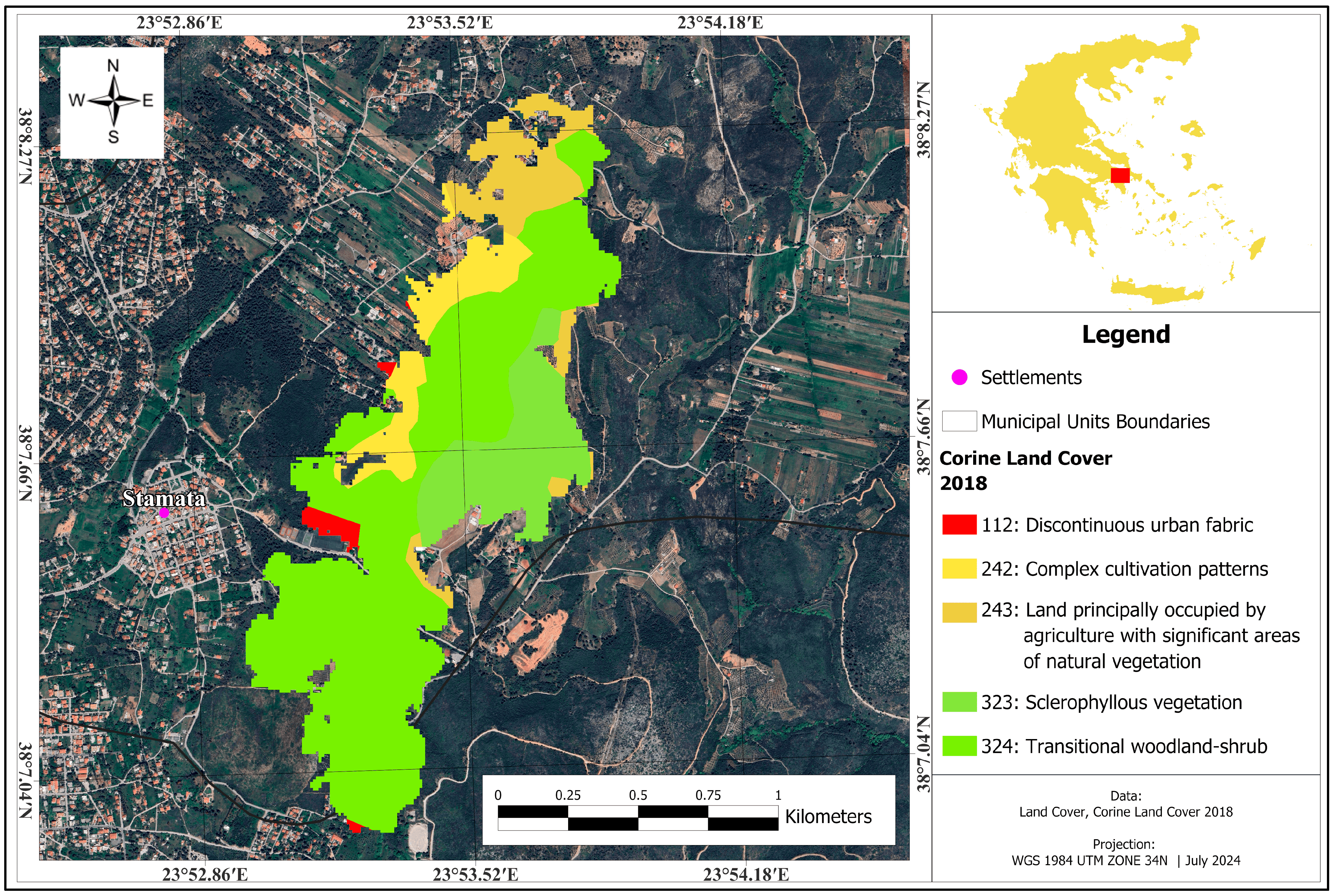


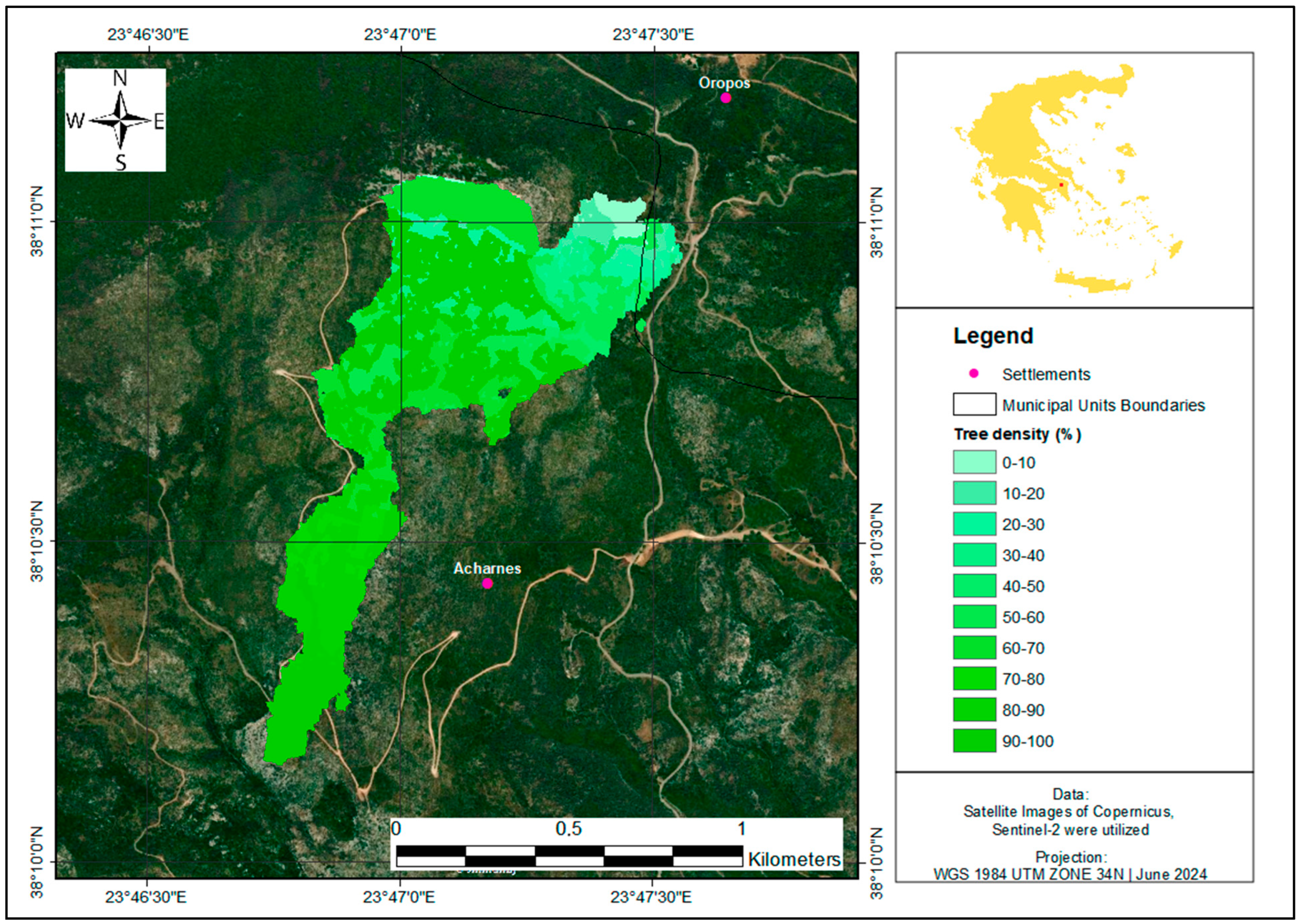

| Data | Format | Resolution | Source |
|---|---|---|---|
| Sentinel-2 Imagery | Optical Level-2A | 10 m | Dataspace Copernicus |
| CORINE Land Cover | Vector (Polygon) | - | Copernicus Land Monitoring Service |
| Tree Density | Raster | 10 m | Copernicus Land Monitoring Service |
| Area | Wildfire Start Date | Sentinel-2 Acquisition Date | Relation with the Wildfire Event |
|---|---|---|---|
| Avenue Varis-Koropiou | 19 June 2024 | 18 June 2024 28 June 2024 | Pre-event Post-Event |
| Achaia—Ilia | 21 June 2024 | 16 June 2024 26 June 2024 | Pre-event Post-event |
| Katsimidi—Parnitha | 29 June 2024 | 23 June 2024 8 July 2024 | Pre-event Post-event |
| Stamata | 30 June 2024 | 26 June 2024 8 July 2024 | Pre-event Post-event |
| dNBR Value | Burn Severity |
|---|---|
| 0.099 | Unburned Areas |
| 0.100–0.269 | Low Severity |
| 0.27–0.439 | Moderate–Low Severity |
| 0.440–0.659 | Moderate–High Severity |
| 0.660–1.300 | High Severity |
| Start Date | Location | Burned Area (km2) | Most Burned Land Type | Validation—Burned Area (km2) | Accuracy (%) |
|---|---|---|---|---|---|
| 19 June | Avenue Varis-Koropiou | 0.82 | Sclerophyllous vegetation | 0.80 | 97.57% |
| 21 June | Achaia-Ilia | 40.55 | Land principally occupied by agriculture, with significant areas of natural vegetation | 38.86 | 95.83% |
| 29 June | Katsimidi-Parnitha | 0.66 | Mixed forest | 0.65 | 98.48% |
| 30 June | Stamata | 1.41 | Transitional woodland—shrub | 1.30 | 92.20% |
| Total Burned Area | 43.44 | 41.61 | 95.79% |
| Avenue Varis-Koropiou | Achaia-Ilia | ||||
|---|---|---|---|---|---|
| Burn Severity | Area (km2) | Percentage (%) | Burn Severity | Area (km2) | Percentage (%) |
| Low | 0.43 | 52.18% | Low | 13.25 | 32.68% |
| Moderate–Low | 0.39 | 47.33% | Moderate–Low | 16.38 | 40.39% |
| Moderate–High | 0.004 | 0.49% | Moderate–High | 10.92 | 26.93% |
| High | 0 | 0.00% | High | 0 | 0.00% |
| Total | 0.824 | 100.00% | 40.55 | 100.00% | |
| Katsimidi-Parnitha | Stamata | ||||
|---|---|---|---|---|---|
| Burn Severity | Area (km2) | Percentage (%) | Burn Severity | Area (km2) | Percentage (%) |
| Low | 0.10 | 15.15% | Low | 0.40 | 28.37% |
| Moderate–Low | 0.32 | 48.48% | Moderate–Low | 0.89 | 63.12% |
| Moderate–High | 0.24 | 36.36% | Moderate–High | 0.12 | 8.51% |
| High | 0 | 0.00% | High | 0 | 0.00% |
| Total | 0.66 | 100.00% | 1.41 | 100.00% | |
| Avenue Varis-Koropiou | Achaia-Ilia | ||||
|---|---|---|---|---|---|
| CLC Code | Area (km2) | Percentage (%) | CLC Code | Area (km2) | Percentage (%) |
| 112: Discontinuous urban fabric | 0.11 | 13.41% | 211: Non-irrigated arable land | 3.36 | 8.28% |
| 121: Industrial or commercial unites and public facilities | 0.10 | 12.20% | 223: Olive groves | 0.03 | 0.07% |
| 242: Complex cultivation patterns | 0.19 | 23.17% | 242: Complex cultivation patterns | 4.86 | 11.98% |
| - | - | - | 243: Land principally occupied by agriculture, with significant areas of natural vegetation | 14.46 | 35.65% |
| - | - | - | 312: Coniferous forest | 0.05 | 0.12% |
| 323: Sclerophyllous vegetation | 0.42 | 51.22% | 323: Sclerophyllous vegetation | 11.57 | 28.53% |
| - | - | - | 324: Transitional woodland and shrub | 6.23 | 15.36% |
| Total | 0.82 | 100.00% | 40.56 | 100.00% | |
| Katsimidi-Parnitha | Stamata | ||||
|---|---|---|---|---|---|
| CLC Code | Area (km2) | Percentage (%) | CLC Code | Area (km2) | Percentage (%) |
| - | - | - | 112: Discontinuous urban fabric | 0.02 | 1.42% |
| - | - | - | 242: Complex cultivation patterns | 0.13 | 9.22% |
| - | - | - | 243: Land principally occupied by agriculture, with significant areas of natural vegetation | 0.15 | 10.64% |
| 313: Mixed forest | 0.37 | 56.06% | 323: Sclerophyllous vegetation | 0.23 | 16.31% |
| 324: Transitional woodland and shrub | 0.29 | 43.94% | 324: Transitional woodland and shrub | 0.88 | 62.41% |
| Total | 0.66 | 100.00% | 1.41 | 100.00% | |
| Avenue Varis-Koropiou | Achaia-Ilia | ||||
|---|---|---|---|---|---|
| Tree Cover Density (%) | Area (km2) | Percentage (%) | Tree Cover Density (%) | Area (km2) | Percentage (%) |
| 1–10 | 0.8200 | 99.49% | 1–10 | 17.1247 | 42.15% |
| 10–20 | 0.0002 | 0.02% | 10–20 | 0.0987 | 0.24% |
| 20–30 | 0.0040 | 0.49% | 20–30 | 0.2620 | 0.64% |
| 30–40 | - | - | 30–40 | 1.2673 | 3.12% |
| 40–50 | - | - | 40–50 | 3.6953 | 9.10% |
| 50–60 | - | - | 50–60 | 6.5659 | 16.16% |
| 60–70 | - | - | 60–70 | 7.2483 | 17.84% |
| 70–80 | - | - | 70–80 | 3.4809 | 8.57% |
| 80–90 | - | - | 80–90 | 0.7861 | 1.93% |
| 90–100 | - | - | 90–100 | 0.0966 | 0.24% |
| Total | 0.8242 | 100.00% | 40.6258 | 100.00% | |
| Katsimidi-Parnitha | Stamata | ||||
|---|---|---|---|---|---|
| Tree Cover Density (%) | Area (km2) | Percentage (%) | Tree Cover Density (%) | Area (km2) | Percentage (%) |
| 1–10 | 0.0137 | 2.11% | 1–10 | 0.9280 | 66.23% |
| 10–20 | 0.0191 | 2.95% | 10–20 | 0.0001 | 0.01% |
| 20–30 | 0.0295 | 4.55% | 20–30 | 0.0001 | 0.01% |
| 30–40 | 0.0286 | 4.41% | 30–40 | 0.0040 | 0.29% |
| 40–50 | 0.0109 | 1.68% | 40–50 | 0.0470 | 3.35% |
| 50–60 | 0.0778 | 12.00% | 50–60 | 0.2050 | 14.63% |
| 60–70 | 0.0958 | 14.78% | 60–70 | 0.1800 | 12.85% |
| 70–80 | 0.0220 | 3.39% | 70–80 | 0.0360 | 2.57% |
| 80–90 | 0.0813 | 12.54% | 80–90 | 0.0010 | 0.07% |
| 90–100 | 0.2695 | 41.58% | 90–100 | 0.0000 | 0.00% |
| Total | 0.6482 | 100.00% | 1.4012 | 100.00% | |
Disclaimer/Publisher’s Note: The statements, opinions and data contained in all publications are solely those of the individual author(s) and contributor(s) and not of MDPI and/or the editor(s). MDPI and/or the editor(s) disclaim responsibility for any injury to people or property resulting from any ideas, methods, instructions or products referred to in the content. |
© 2025 by the authors. Licensee MDPI, Basel, Switzerland. This article is an open access article distributed under the terms and conditions of the Creative Commons Attribution (CC BY) license (https://creativecommons.org/licenses/by/4.0/).
Share and Cite
Castro-Melgar, I.; Tsagkou, A.; Zacharopoulou, M.; Basiou, E.; Athinelis, I.; Katris, E.-A.; Kalavrezou, I.-E.; Parcharidis, I. Wildfires During Early Summer in Greece (2024): Burn Severity and Land Use Dynamics Through Sentinel-2 Data. Forests 2025, 16, 268. https://doi.org/10.3390/f16020268
Castro-Melgar I, Tsagkou A, Zacharopoulou M, Basiou E, Athinelis I, Katris E-A, Kalavrezou I-E, Parcharidis I. Wildfires During Early Summer in Greece (2024): Burn Severity and Land Use Dynamics Through Sentinel-2 Data. Forests. 2025; 16(2):268. https://doi.org/10.3390/f16020268
Chicago/Turabian StyleCastro-Melgar, Ignacio, Artemis Tsagkou, Maria Zacharopoulou, Eleftheria Basiou, Ioannis Athinelis, Efstratios-Aimilios Katris, Ioanna-Efstathia Kalavrezou, and Issaak Parcharidis. 2025. "Wildfires During Early Summer in Greece (2024): Burn Severity and Land Use Dynamics Through Sentinel-2 Data" Forests 16, no. 2: 268. https://doi.org/10.3390/f16020268
APA StyleCastro-Melgar, I., Tsagkou, A., Zacharopoulou, M., Basiou, E., Athinelis, I., Katris, E.-A., Kalavrezou, I.-E., & Parcharidis, I. (2025). Wildfires During Early Summer in Greece (2024): Burn Severity and Land Use Dynamics Through Sentinel-2 Data. Forests, 16(2), 268. https://doi.org/10.3390/f16020268







